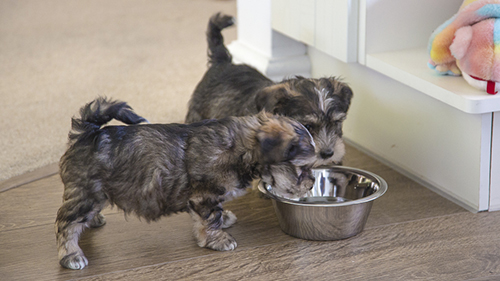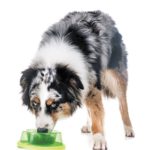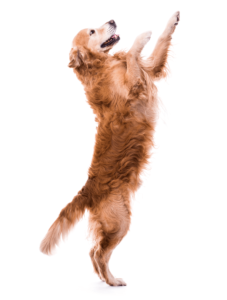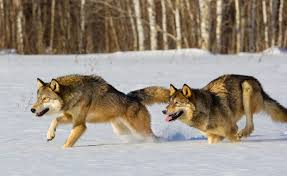Please note: I will refer to all dogs as he. This saves writing “he or she” or calling your precious dog “it”

Your perfect dog.
Everyone wants their dog to be perfect, but most of our dogs have got problems. We have two dogs ourselves and neither of them are perfect. But if we can only learn to communicate with our dogs, we can improve their lives along with our own and greatly reduce any unwanted behaviour, even if they are natural traits.
Is your dog naughty?
Many owners consider their dogs to be ‘naughty’ or ‘badly behaved’ but we must realize that canines react to stimuli and do not know how to be ‘vindictive’ or ‘vengeful’. Dogs live in the moment, unlike us humans who seem to live in the past, the present and worry about what’s going to happen in the future.
Dogs can teach us how to live!
Our negative or positive thoughts have a profound affect on our dogs. They are completely tuned in to our emotions and this is the key to communicating with our canine friends. As Cesar Millan says “you don’t get the dog you want, you get the dog you need!”

Do you want to know your dog?
If you really want to know how your dog thinks and why he may be exhibiting behaviour you don’t like, get in touch. With knowledge about your dog’s traits, characteristics and why he acts as he does, we can learn to adjust his behaviour to ensure you have a well mannered dog. He will be a happy dog who will enhance your life and the lives of those around him.

I am a dog behaviourist, not a trainer
Please note I am not a trainer, I am a dog behaviourist. I will assess the problem behaviour your dog is exibiting and suggest a solution. You will then be shown how to implement that solution and prevent the behaviour. Every dog is different and one dog’s solution may not suit another dog. The initial consultation will take around 2 hours. This is so I can see how your dog reacts to stimuli and how he is in his home environment and out on a walk.
So what kind of behaviours are we talking about:
Some behaviours are more ‘unwanted’ than others. Below is a list of those that are particularly troublesome to owners and canines:
-
-
- Pulling on the lead
- Separation anxiety
- House training
- *Food aggression
- *Fearfulness

- Mouthing or biting
- *Jumping up
- Dog to dog aggression
- Recall
- Resource guarding
- Barking
- Chewing

- Digging
- Begging
- Coprophagia (eating poop)
- Phobias and obsession
-
*images – fearfulness, food aggression and jumping up
A litte bit of history for you
Canines are pack animals. Animals that live in a pack, such as wolves, have a tight social structure, living in family groups, with a pecking order or hierarchy. They hunt as a pack, with a strong, mentally agile, high energy wolf usually taking the top spot as pack leader, the Alpha male. He is often supported by his mate, the Alpha female. According to research, a female is just as likely to be the pack leader as a male.
The domestic dog
Domestic dogs like to know their place within their ‘human pack’, just like a wolf pack. Dogs are playful and seem to enjoy an exuberant play fight with a dog pal or sibling. They will scent mark their territory to inform other dogs of their presence. Many breeds, such as Border Collies and Greyhounds have a strong prey drive. These traits are in common with wolf behaviour.
 Wolf to domestic dog
Wolf to domestic dog
It is suggested that it was about 100,000 years ago that dogs changed direction genetically from the wolf. As for their interaction with humans, perhaps they were enticed into the camps by the smell and promise of food. In lean times, it may have been their hunger that overcame their caution. Dogs are renowned for having opportunistic tendencies. I think this is the most likely start of human association with dogs, rather than them being enslaved in the first instance. From skeletons found from 14,000 years ago, the jaw was shown to be different than that of a typical wolf. The jaw was shorter with more crowded teeth. This is evidence of change. Even so, much of a dog’s DNA is the same as the wolf.

The truth on a DNA level, is that the same DNA sequences as wolves are found in all our modern pure breeds, except for Norwegian breeds such as the Norwegian Elkhound whose DNA has ancient origins.
In Roman times
In Roman times, there were just 6 different types of dogs as follows:
- Villatici – house or guardian dogs
- Pastorales Pecuarii – shepherd dogs
- Venatici – sporting dogs
- Pugnaces and Bellicosi – war dogs
- Nares Sagaces – scent hounds
- Pedibus Celeres – sight hounds
By the year 1800, there were still only 15 distinct breeds, all of which were recorded in an encyclopaedic compendium of dog breeds in Britain.

About the Dingo
Because no dog fossils have been found in Tasmania, it is assumed that the Dingo didn’t exist 12,000 years ago, when Tasmania broke away from the mainland of Australia. The oldest fossils ever found in Australia are thought to date back to 1500 BC. Dingo bones were excavated in the 1960s from the Madura Cave on the southern edge of the Nullarbor Plains, SW of Western Australia (1060 km east of Perth). They have very recently been re-evaluated using accurate radiocarbon dating and found to be between 3348 and 3081 years old. (Scientific Reports volume 8, Article number: 9933 (2018)
As for the 400+ breeds we have now…
Those dogs that had certain traits, were utilised to help humans improve their living, daily chores and jobs. Those prone to barking a lot were used as guard dogs. The smaller short legged dogs were used for flushing out, rabbiting etc.. The sleeker longer legged faster animals were better at chasing and hunting. A high prey drive could be channelled into using the dog for herding, such as our modern ‘Pastoral’ group of dogs today.

But unfortunately…
There were those breeders who decided to breed dogs to look a certain way. This with no thought of the dog’s welfare. Now we have many breeds suffering various problems with breathing, skin complaints, eye problems, hip dysplasia etc.. Also in-breeding has caused problems in many breeds. Here are 5 susceptible breeds that come to mind:
- The Pug – The following health problems taken from petMD. The Pug is prone to major health problems like Pug Dog Encephalitis (PDE) and canine hip dysplasia (CHD), as well as minor concerns like elongated palate, patellar luxation, stenotic nares, Legg-Perthes disease, entropion, keratoconjunctivitis sicca (KCS), hemivertebra, obesity, and skin infections. Nerve degeneration, demodicosis, seizures, distichiasis, and allergies are occasionally seen in this breed of dog. Its facial wrinkles must be kept clean to prevent skin fold dermatitis, a form of skin inflammation. The Pug is also sensitive to heat and anesthesia.
- The Bulldog – Again, according to petMD. Heat stroke is more common with this breed. Some of the major health problems the Bulldog is susceptible to are keratoconjunctivitis sicca (KCS), ventricular septal defect, canine hip dysplasia (CHD), shoulder luxation, internalized tail, stenotic nares, and elongated soft palate.
- The Shar Pei – According to ‘vetstreet’ The Shar-Pei has many health issues, and Shar Pei owners may develop a close relationship with their veterinarian. Concerns include hip and elbow dysplasia; patellar luxation; hypothyroidism; eye problems such as entropion, retinal dysplasia and glaucoma, allergies; and skin fold infections.
- The Pekingese – Health problems include (according to a pet insurance company) brachycephalic airway syndrome, which causes breathing difficulty; intervertebral disc disease; eye diseases; early-onset heart murmurs; and syringomyelia.
- Cavalier King Charles Spaniel – and again, according to petMD, patellar luxation, and entropion, or major problems like, mitral valve disease (MVD), and canine hip dysplasia (CHD). Sometimes retinal dysplasia is seen in the breed. Also you can see from the image, they can be prone to syringomyelia

Do your research and be aware
Suffice to say, it is a good idea to thoroughly research the breed of dog you intend to acquire. Remember it is common knowledge that cross breeds are less likely to have health problems because of the extended gene pool the offspring come from. If the dog you have is one of those prone to health problems, forewarned is forearmed!
Contact and Fees:
Go to Contact and Fees: to find out about more about my ‘no fix no fee’ promise. Send me an email; I may be able to give some advice by email or phone. Otherwise I can visit you at your home. I will happily visit within a 50 mile radius of Builth Wells.
